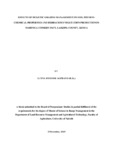Effects of holistic grazing management on soil physico-chemical properties and herbaceous vegetation production in Naibunga Conservancy, Laikipia County, Kenya
This study evaluated the effects of holistic grazing management (HGM) on biomass production and soil properties under holistic and non-holistic grazing sites. The study was conducted in two Group Ranches namely, Koija and Il Motiok in Naibunga Conservancy, Laikipia County, Kenya. Vegetation attributes and soil parameters were determined in four plots randomly sited and established within the Il Motiok Ranch, which is under HGM, and in the same number of plots sited and established in Koija Ranch which is under free-range grazing system.



